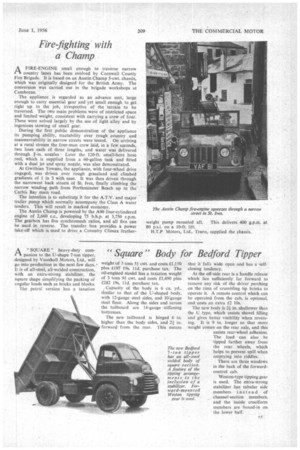Fire-fighting with a Champ
Page 103

If you've noticed an error in this article please click here to report it so we can fix it.
A FIRE-ENGINE small enough to traverse narrow -M. country lanes has been evolved by Cornwall County Fire Brigade. It is based on an Austin Champ 5-cwt. chassis, which was originally designed for the British Army. The conversion was carried out in the brigade workshops at Camborne.
The appliance is regarded as an advance unit, large enough to carry essential gear and yet small enough to get right up to the job, irrespective of the terrain to be traversed. The two main problems were of restricted space and limited weight, consistent with carrying a crew of four. These were solved largely by the, use of light alloy and by ingenious stowing of small gear.
During the first public demonstration of the appliance its pumping ability, tractability over rough country and manceuvrability in narrow streets were tested. On arriving at a rural stream the four-man crew laid, in a few seconds, two lines each of three lengths, and water was delivered through fin. nozzles Later the 120-ft, small-bore hose reel, which is supplied from a 60-gallon tank and fitted with a dual jet and spray nozzle, was also demonstrated.
At Gwithian Towans, the appliance, with four-wheel drive engaged, was driven over rough grassland and climbed gradients of 1 in 3 with ease. It was then driven through the narrowest back streets of St. Ives, finally climbing the narrow winding path from Porthminster Beach up to the Carbis Bay main road.
The intention is to substitute it for the A.T.V. and major trailer pump which normally accompany the Class A water tenders. This will result in marked economy.
The Austin Champ is powered by the A90 four-cylindered engine of 2,660 c.c., developing 75 b.h.p. at 3,750 r.p.m. The gearbox has five synchromesh ratios, and all five can be used in reverse. The transfer box provides a power take-off which is used to drive a Coventry Climax feather




























































































































































































































































